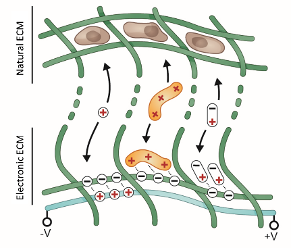Materials for Bioelectronics
Inside the body bioelectronic interfaces operate in a chemically and mechanically challenging environment. The implanted device must not produce adverse reactions (e.g. foreign body response) in the host and should survive extended periods of time while maintaining its functionality. This places stringent requirements on the materials that make up the bioelectronic devices and system.
We aim to address some of the challenges by engineering materials that resemble the mechanical and biochemical properties of soft tissues such as the brain and additionally transcend purely electrical or purely biological functions.
One focus is on hydrogels possessing both electronic and ionic conductivity combined with bioactive scaffolds. Their physical and biological properties can be electrically controlled which is the basis for sensors and actuators that operate in the electrical, biochemical and mechano-biological domains.
Another focus is on composites. These are formulated by mixing nanoparticles (e.g. platinum, gold) with silicones or hydrogels. Composites can be engineered to be soft and stretchable unlike bulk metals. Using materials well-known in implantable devices may offer a convenient route to translation.
Key publication: I. R Minev “Electronic tissue technologies for seamless biointerfaces” Journal of Polymer Science, 2023

Concept for a hydrogel based bioelectronic material based on hydrogels with engineered electrical and biochemical properties. It may be used to build multimodal sensors and actuators.
Adapted from: Minev et al, J. of Polymer Science 2023.

Platinum-silicone composite that remains electrically conductive when tensile strain is applied.
The material is printable and can be integrated in soft electrode arrays.
